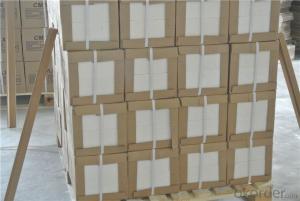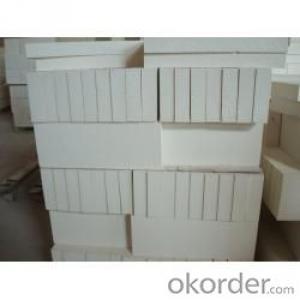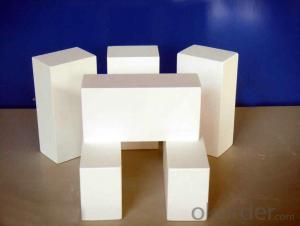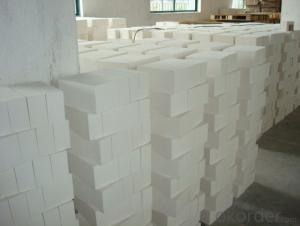JM Mullite Thermal Storage Bricks Thermal Insulating Brick
- Loading Port:
- Tianjin
- Payment Terms:
- TT OR LC
- Min Order Qty:
- 2 m.t.
- Supply Capability:
- 1000 m.t./month
OKorder Service Pledge
OKorder Financial Service
You Might Also Like
Bubble Alumina Brick. We stock in both 2.5 & 3” sizes. We also carry double bump interlocking anchor styles. For use up to 1800C, these brick have excellent insulating properties as well as high hot strengths.
Insulating firebrick, we carry produces thirteen types of Insulating Fire Brick for use in applications from 2,000°F (1,093°C) to 3,200°F (1,760°C). Each type is formulated to meet specific thermal and physical requirements and after firing is machined to precise tolerances.
Made from high purity refractory clays and other ceramic raw materials, these insulating fire brick contain a carefully graded organic filler which is burned out during manufacture to give a uniform controlled pore structure.
Advantages of bubble alumina brick.
High Insulating Va
The high compressive strength of bubble alumina brick allows for self-supporting structures at elevated temperatures. Insulating fire brick are compatible with dense fire brick and add strength to the whole construction.
.
Strong
The high compressive strength of bubble alumina brick allows for self-supporting structures at elevated temperatures. Insulating fire brick are compatible with dense fire brick and add strength to the whole construction.
Low Heat Storage
Lower heat storage versus dense brick means reduced fuel costs in cyclically operated heating equipment.
Application
DJM 26 Light Weight Insulating fire brick are used for the lining of converter, alternating current arc furnace, direct Current arc furnace and the ladle slag line, etc.
Company Advantage
(1)Long Insulating Fire Brick manufacture history: 25 years manufacturer
(2)Advanced equipment
(3)Diversification of production standards: ISO ANSI FEPA JIS ASTM
Equipment
1 unit of Ceramic Abrasive (SG Abrasive) pilot production line
1 unit of high-end coated abrasives (abrasive cloth) production line
2 units of Boron Carbide production lines
Q1 What’s the transport method?
A1 FCL delivery goods with wooden pallet or wooden case by sea; If LCL delivery, must with wooden case; Sometimes need open top, flat rack or bulk cargo.
Q2 What’s the required payment term?
A2 Generally 30% TT as the prepayment, 70% TT before delivery. If need, 100% Irrevocable Letter of Credit or negotiation.
Q3 Which country are our products exported to?
A3 Apart from entire Chinese market, the US, Russia, Japan, Korea, Australia and some Southeast Asian Nations.
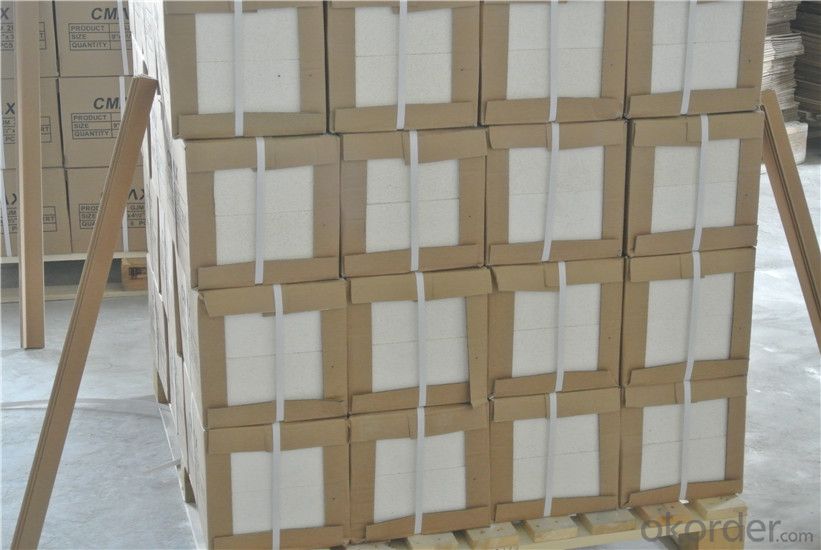
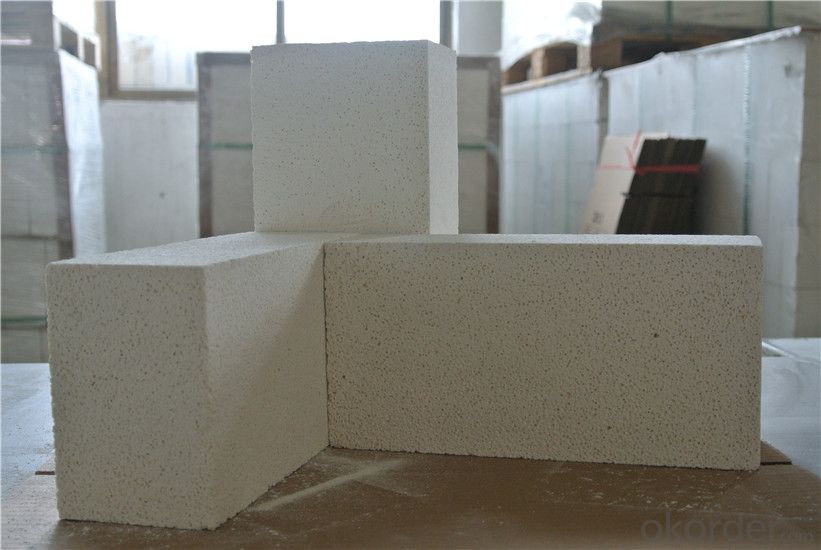
- Q:How does the density of an insulating fire brick affect its performance?
- The performance of an insulating fire brick is heavily influenced by its density. Generally, bricks with higher density provide superior thermal insulation and mechanical strength compared to bricks with lower density. The density of an insulating fire brick directly affects its thermal insulation capabilities. Bricks with higher density have smaller pores and a more compact structure, resulting in better insulation against heat transfer. This means that the brick can effectively resist the transfer of heat, maintaining a consistent temperature within the structure it is used in. On the other hand, bricks with lower density have larger pores and a less compact structure, allowing for more heat transfer and reducing their insulating capabilities. Apart from thermal insulation, the density of an insulating fire brick also impacts its mechanical strength. Bricks with higher density generally have greater structural integrity and resistance to mechanical stress. This means that they are more reliable and durable, capable of withstanding higher temperatures and physical pressures without cracking or breaking. Conversely, bricks with lower density may be more fragile and prone to damage, limiting their performance in harsh conditions. Therefore, when selecting an insulating fire brick for a specific application, it is important to consider its density. A balance must be struck between achieving optimal thermal insulation and mechanical strength. Factors such as the desired level of insulation, operating temperature, and structural requirements of the application should be taken into account to determine the appropriate density of the insulating fire brick for maximum performance.
- Q:What is the price of thermal insulation brick for exterior wall?
- Hello, the exterior wall insulation has many practices, useful insulation bricks, but also useful particles of polystyrene insulation mortar mixed (thickness is not the same, the price is not the same);
- Q:Can insulating fire bricks be used in lime plants?
- Indeed, insulating fire bricks have the capability to be utilized in lime plants. These bricks are uniquely crafted to possess a remarkably low thermal conductivity, thus enabling them to effectively impede the transfer of heat. In the context of lime plants, where elevated temperatures are necessary for the calcination process, insulating fire bricks can be employed to line the kilns and other zones exposed to high temperatures. By doing so, these bricks aid in the preservation of heat within the lime kilns, resulting in a reduction of energy loss and an enhancement of overall efficiency. Furthermore, insulating fire bricks possess resistance against chemical attacks and are able to endure the harsh conditions experienced in lime plants, rendering them a suitable and appropriate choice for this particular application.
- Q:Can insulating fire bricks be used as a thermal barrier?
- Yes, insulating fire bricks can be used as a thermal barrier. Insulating fire bricks are specifically designed to have low thermal conductivity, meaning they are able to effectively reduce heat transfer. This makes them an excellent choice for thermal insulation applications. They are commonly used in industries where high temperatures are involved, such as in furnaces, kilns, and other heat-intensive processes. Insulating fire bricks can help to minimize heat loss, maintain consistent temperatures, and improve energy efficiency. Additionally, their lightweight nature makes them easy to handle and install, further enhancing their suitability as a thermal barrier.
- Q:Are insulating fire bricks suitable for insulation in boilers for steam generation?
- Yes, insulating fire bricks are suitable for insulation in boilers for steam generation. Insulating fire bricks are specifically designed to have excellent thermal insulation properties, which make them ideal for use in high-temperature applications such as boilers. These bricks have a low thermal conductivity, meaning they can effectively reduce heat transfer and prevent heat loss. This insulation capability helps to maintain high temperatures within the boiler, improving energy efficiency and reducing fuel consumption. Additionally, insulating fire bricks are resistant to thermal shock, which is crucial for withstanding the extreme temperature fluctuations that occur in steam generation. Overall, using insulating fire bricks in boilers for steam generation can enhance the thermal efficiency and performance of the system.
- Q:How do insulating fire bricks help reduce fuel consumption?
- Efficient insulation in high-temperature environments is facilitated by insulating fire bricks, resulting in reduced fuel consumption. These bricks are composed of lightweight materials that possess high thermal resistance, enabling them to retain heat and prevent its dissipation. Through the reduction of heat loss, insulating fire bricks establish an energy-efficient setting that necessitates less fuel to sustain the desired temperature. Furthermore, the insulating properties of these bricks facilitate the even distribution of heat, curtailing the need for excessive fuel consumption to rectify uneven heating. Ultimately, the utilization of insulating fire bricks conserves fuel and diminishes energy wastage across a range of industrial applications, including kilns, furnaces, and ovens.
- Q:Do insulating fire bricks require a refractory mortar for installation?
- Yes, insulating fire bricks typically require a refractory mortar for proper installation. Refractory mortar helps to secure the bricks in place, fill any gaps or voids, and provide additional insulation and strength to the overall structure.
- Q:Are insulating fire bricks suitable for applications requiring low thermal conductivity?
- Yes, insulating fire bricks are suitable for applications requiring low thermal conductivity. Insulating fire bricks are specifically designed to have low thermal conductivity, making them ideal for situations where heat insulation is necessary. These bricks are made from lightweight and porous materials, such as clay and other refractory materials, which provide excellent insulation properties. The porous structure of insulating fire bricks traps air within the material, reducing heat transfer and resulting in low thermal conductivity. This makes them effective in applications such as kilns, furnaces, and other high-temperature environments where minimizing heat loss is crucial. Overall, insulating fire bricks are a reliable choice for applications that demand low thermal conductivity.
- Q:Can insulating fire bricks be used in rocket stove designs?
- Insulating fire bricks are capable of being incorporated into the designs of rocket stoves. Rocket stoves are renowned for their efficient combustion and heat transmission, and the utilization of insulating fire bricks can enhance this level of performance. These bricks are produced from lightweight materials that possess excellent insulating properties, allowing them to effectively retain and reflect heat. The combustion chamber of a rocket stove is typically lined with insulating fire bricks in order to maximize the transfer of heat to the cooking surface or the area being heated. The bricks aid in the retention of heat within the combustion chamber, ensuring that a greater portion of the energy generated from the burning fuel is utilized to heat the cooking surface, rather than being dissipated into the surrounding environment. Moreover, insulating fire bricks are capable of enduring high temperatures, making them an ideal choice for inclusion in rocket stove designs. They are specifically engineered to withstand the intense heat generated by the combustion process, guaranteeing that the bricks will not fracture or shatter under such circumstances. In conclusion, the incorporation of insulating fire bricks into the designs of rocket stoves can enhance the efficiency and heat transmission of the stove, resulting in a more efficient and sustainable solution for cooking or heating purposes.
- Q:Can insulating fire bricks be used for insulation in gas furnaces?
- Indeed, insulation in gas furnaces can be achieved by utilizing insulating fire bricks. These bricks are crafted from lightweight materials like clay and other minerals, boasting remarkable insulation capabilities. Specifically engineered to endure extreme temperatures, they are extensively employed in industrial settings, notably gas furnaces. By reducing heat loss, enhancing energy efficiency, and sustaining elevated temperatures within the furnace, these bricks play a crucial role. Furthermore, they exhibit resistance to thermal shock and can withstand the corrosive impact of gases and chemicals commonly found in gas furnaces. Hence, insulating fire bricks serve as a suitable option for insulating gas furnaces.
1. Manufacturer Overview |
|
|---|---|
| Location | |
| Year Established | |
| Annual Output Value | |
| Main Markets | |
| Company Certifications | |
2. Manufacturer Certificates |
|
|---|---|
| a) Certification Name | |
| Range | |
| Reference | |
| Validity Period | |
3. Manufacturer Capability |
|
|---|---|
| a)Trade Capacity | |
| Nearest Port | |
| Export Percentage | |
| No.of Employees in Trade Department | |
| Language Spoken: | |
| b)Factory Information | |
| Factory Size: | |
| No. of Production Lines | |
| Contract Manufacturing | |
| Product Price Range | |
Send your message to us
JM Mullite Thermal Storage Bricks Thermal Insulating Brick
- Loading Port:
- Tianjin
- Payment Terms:
- TT OR LC
- Min Order Qty:
- 2 m.t.
- Supply Capability:
- 1000 m.t./month
OKorder Service Pledge
OKorder Financial Service
Similar products
New products
Hot products
Related keywords
